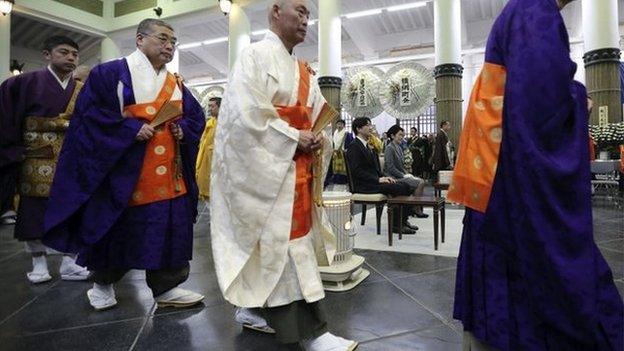Return to Iwo Jima 70 years on
- Published
Rupert Wingfield-Hayes retraces the steps of those who fought in the Iwo Jima battle
Iwo Jima is a name I have known from childhood.
Perhaps it was from a Saturday night watching John Wayne in The Black Sands of Iwo Jima. That came long before Clint Eastwood made the tiny island famous again with Flags of Our Fathers and Letters From Iwo Jima.
To me as a child in England it was a strange exotic name for a place I never imagined I would see. So you can perhaps imagine my excitement as our plane banks sharply to the left and the unmistakable volcanic cone of Mount Suribachi appears in my window.
As the plane touches down the flight attendant's voice comes over the intercom. "Ladies and gentlemen welcome to Iwo Jima, before leaving the aircraft please make sure you have not forgotten any of your carry on items."
It sounds so normal. It is anything but.
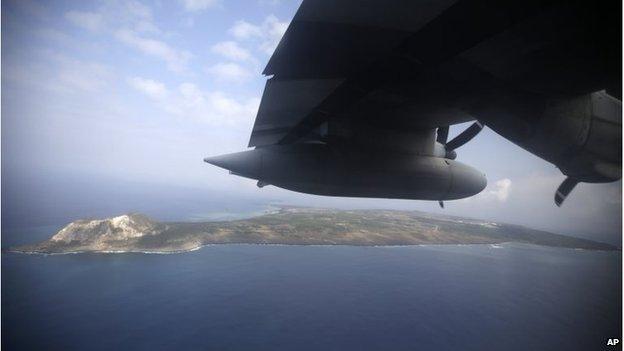
Japan officially reinstated Iwo Jima's original name, Iwo To, in 2007
Iwo Jima, a military base, is open to outsiders for only one day each year, and then only to US veterans, their families, and a very few journalists travelling with them.
Seventy years on from the terrible battle that was fought here, 26 veterans have come back. The youngest is in his late eighties. Most are in their early nineties. For most this is the first time they have seen the island since 1945. The excitement and emotion is palpable.
Standing on the runway we stare at the hulking mass of Mount Suribachi four miles (7km) away on the southern tip of the island. In 1945 it was a Japanese fortress, a warren of tunnels, bunkers and gun emplacements. More than 500 young Marines died on the first day of battle, many of them from fire coming from Suribachi.
It took four days for the Marines to fight their way to the top where they planted a US flag. The photo of them doing so has become perhaps the most famous war photograph ever taken.
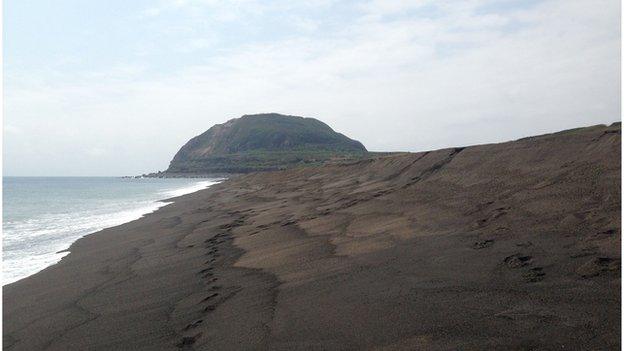
Japanese troops opened fire from Mount Suribachi as the US forces landed on what became known as Invasion Beach
Today the elderly veterans are whisked up the mountain by minibus. I am left to walk.
An hour later as I reach the top one of the old men is playing The Halls of Montezuma on a harmonica. Behind him two more are once again raising the Stars and Stripes over the mountain.
Standing nearby is Hershel "Woody" Williams. Hanging around his neck is the Congressional Medal of Honor, America's highest award for bravery. On the day they raised the flag here, Woody was far below assaulting Japanese bunkers with a flamethrower. It was perhaps the most dangerous job in the Marine Corps.
"I am thinking of those who didn't make it home," he tells me. "I am thinking of the heroes who died here. I lost three of my closest friends here. I am not a hero, they are."

The flag-raising photograph was an image that became known around the world
Through the smoke and chaos of the battle on the plain below, Woody looked up and saw the Stars and Stripes flying over the mountain. A cheer rippled through the US lines. The ships offshore blew their horns.
"It was the flag that made the difference," he says. "It was was the first time we had taken Japanese territory. This was the first time in all the fighting that we got part of their country. That said to us, and to those back in America, we are winning this thing. Up until that point there were a lot of us who didn't think we were."
All but one of the veterans on Mount Suribachi today is American. The exception is a small Japanese gentleman in suit and tie standing slightly apart. For 88-year-old Tsuruji Akikusa there is nothing to celebrate. Looking down from the mountain he too is filled with memories, awful ones. As he turns to me, tears well up in his eyes.
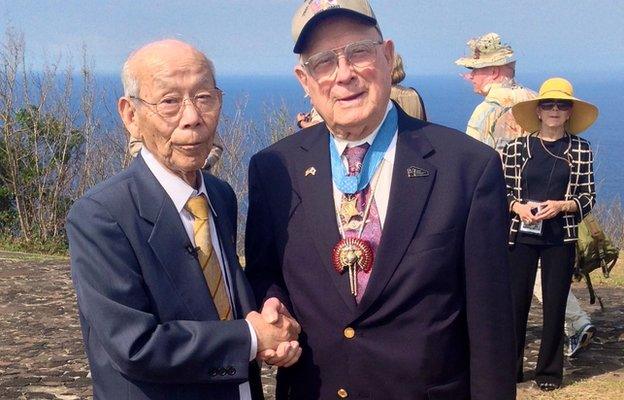
Tsuruji Akikusa, here with Woody Williams, was one of only 1,000 Japanese soldiers to survive Iwo Jima, from a force of 20,000
"It is very hard," he says. "In my mind images of what happened then have suddenly come flooding back. I feel very, very sad."
In 1945, Mr Akikusa was an 18-year-old radio operator in the Japanese navy. On the morning of 19 February he looked out from his bunker and saw the vast American invasion force.
"I was overwhelmed," he says. "How could they have so many ships? There were more than the entire Japanese navy. It was then I realised we were going to lose the war."
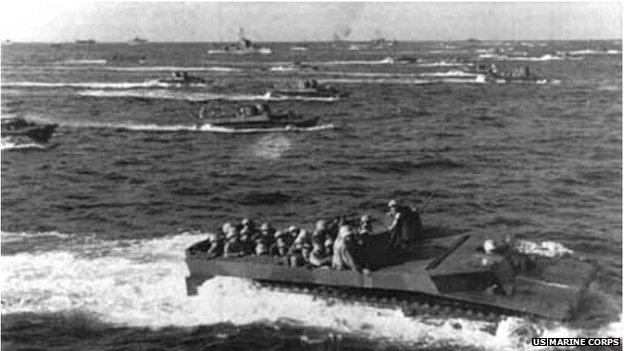
The US sent a 100,000-strong force to the island in February 1945
In the opening naval barrage Mr Akikusa was badly injured. Three fingers were blown off his right hand. As the battle raged on for week after week, conditions in the tunnels beneath Iwo Jima grew worse and worse. They had run out of ammunition and were slowly starving. Mr Akikusa even ate the maggots feeding on his suppurating wounds.
But surrender was unthinkable.
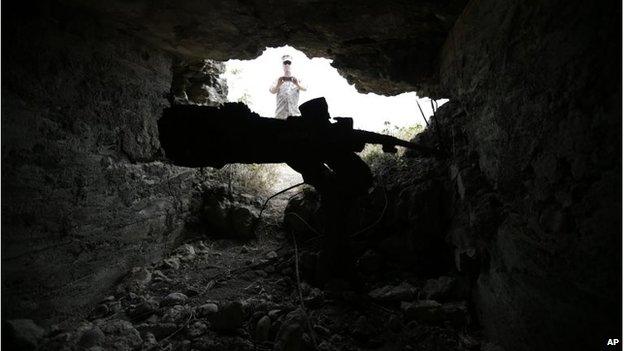
Thousands of Japanese troops spent weeks entrenched in tunnels underneath the island
With their own casualties mounting, the Americans resorted to more and more extreme measures.
"They pumped water into our cave," Mr Akikusa says. "We were all filthy. The cave stank of excrement and dead bodies. So some jumped in to the water to wash. Then the water exploded. Gasoline had been mixed with the water. The cave became a sea of flame.
"People were burning; their skin was hanging and bleeding. It was like hell."
It wasn't until the end of April that Mr Akikusa was dragged from the tunnels, starving and semi-conscious, by a US Marine. At the end of the battle 20,000 Japanese troops were dead. Only 1,000 survived. For years after returning home Mr Akikusa suffered in silence, not telling anyone what had happened to him. Even today, Iwo Jima is a story Japan struggles to deal with.
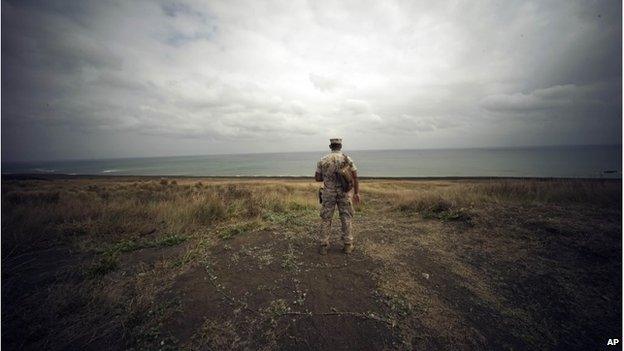
Iwo Jima is only open to outsiders one day a year
There is no such anguish for the Americans. Instead there is much excitement that Mr Akikusa is here.
Every US veteran wants to shake his hand and have a photo taken together. Whether this is a poignant moment of reconciliation, or memento-gathering, I am not sure. Even after 70 years there is still a gulf in understanding.
But, whether victor or vanquished, the old men here on Iwo Jima do share one thing, that is abhorrence of war.
- Published1 March 2015
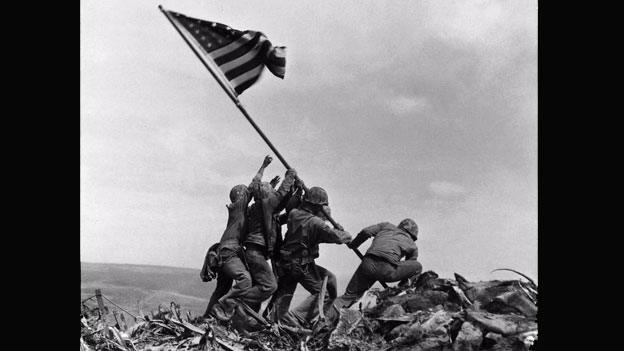
- Published10 March 2015
